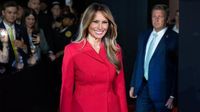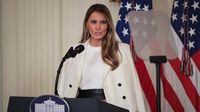In a swirl of media drama that has captivated both the fashion and political worlds, First Lady Melania Trump has decisively rejected a high-profile offer to appear on the cover of Vanity Fair, sparking a heated internal revolt among the magazine’s staff and reigniting a long-simmering debate over how American magazines treat Republican First Ladies. The saga, which unfolded over July and August 2025, has become a flashpoint for broader cultural tensions, with both sides of the political spectrum weighing in on what a magazine cover really means in today’s divided America.
It all started when Mark Guiducci, the newly appointed global editorial director of Vanity Fair, reached out to Melania Trump with a lucrative offer to grace the magazine’s cover. According to The Indian Express and Page Six, the move was seen as a bold play to revive the magazine’s flagging fortunes and web traffic, which had reportedly declined by 39% over the previous four years. But the idea quickly met fierce resistance from within Guiducci’s own newsroom.
As news of the proposed cover spread, staffers at Vanity Fair erupted in outrage. One mid-level editor, speaking to the Daily Mail, threatened mass resignations if the First Lady’s feature went ahead. “I will walk out the motherf***ing door, and half my staff will follow me… If I have to work bagging groceries at Trader Joe’s, I’ll do it. It sickens me,” the editor declared. The sentiment was echoed by others who insisted, “We are not going to normalize this despot and his wife; we’re just not going to do it. We’re going to stand for what’s right.”
Yet, not all staffers were convinced that the threat of a walkout was real. Another Vanity Fair employee told the Daily Mail, “It’s all talk. If they put her on the cover, people will protest and gripe about it, but I don’t see anyone quitting such a prestigious job over that.” Still, the episode exposed deep divisions within the magazine, reflecting the broader cultural and political rifts that have shaped American media in recent years.
For Melania Trump, the offer was apparently never a serious consideration. According to sources close to the First Lady cited by Page Six and The Indian Express, she “laughed” at the idea and immediately dismissed it. “She doesn’t have time to be sitting in a photo shoot. Her priorities as First Lady are far more important… These people don’t deserve her anyway,” the source said. In a December 2024 interview with Fox News’ Fox & Friends, Melania herself downplayed the significance of magazine covers: “I’ve been there. For me, we have so many other important things to do than to be on the cover of any magazine. I think that life would not change for anybody if I’m on the cover.”
This is not the first time Melania Trump has been at the center of a magazine controversy. Despite her background as a model and her previous appearances on covers, including Vogue in 2005 and Vanity Fair Mexico in 2017, she was conspicuously absent from the covers of major American fashion magazines throughout Donald Trump’s first presidency. Meanwhile, Democratic First Ladies such as Michelle Obama and Jill Biden appeared multiple times on Vogue and other publications during their husbands’ terms. From 2009 to 2016, Michelle Obama graced Vogue three times, while Jill Biden appeared twice in just four years.
Conservative commentators have long argued that this disparity reflects a political bias in the media. As Fox News reported on August 28, 2025, the network’s hosts criticized Vanity Fair staff for their reaction, with some calling for the firing of editors who opposed the cover and others pointing out the double standard compared to the treatment of Democratic First Ladies. “If Melania did get a cover, I’d buy several copies,” said Ainsley Earhardt, co-host of Fox & Friends. “The magazine’s stock should rise for showing both sides.”
On the other side, some progressive voices within the media have defended the staff’s outrage, framing it as a stand against what they see as an attempt to “normalize” the Trump family. The episode has become yet another proxy battle in the ongoing culture wars, with each side accusing the other of hypocrisy and intolerance.
Behind the scenes, the drama also highlights the pressures facing Vanity Fair as it seeks to reinvent itself under new leadership. The magazine, once known for its groundbreaking photography and hard-hitting journalism under editors like Tina Brown and Graydon Carter, has struggled to maintain its relevance in the digital age. Under former editor Radhika Jones, the magazine’s pivot toward progressive politics and underrepresented voices led to declining sales and web traffic, with some covers—such as the April 2018 issue featuring Lena Waithe—selling far fewer copies than previous editions.
Guiducci’s bid to feature Melania Trump was seen by some as an attempt to recapture the magazine’s ability to make news and drive conversation. As Paula Froelich wrote in NewsNation, “Vanity Fair needs a hit. While the concept of a newsstand ‘cover’ is pretty antiquated these days… a good story is a major driver of web traffic. Without traffic, there are no ads. Without ads, the magazine—both online and print—is over.” Froelich argued that Guiducci should take risks and stir up controversy, even if it means alienating some staffers.
For her part, Melania Trump appears unfazed by the attention. She continues to focus on her philanthropic initiatives, including her “Fostering the Future” program for foster children and her “Be Best” campaign targeting cyberbullying and opioid abuse. She also played a role in bringing the “Take It Down Act” into effect, requiring social media platforms to remove non-consensual intimate images. Beyond these efforts, she is involved in the Presidential Artificial Intelligence Challenge, encouraging youth engagement with AI, and has taken on foreign policy projects, including penning a personal letter to Vladimir Putin during Russia-Ukraine peace talks urging protection for children and future generations. Melania is also working on a documentary for Amazon, writing a memoir, and developing an AI-powered audiobook.
The episode may have left Vanity Fair staff divided and its leadership scrambling for a new direction, but for Melania Trump, it’s just another headline to shrug off. As one insider summed up to Page Six: “She’s way above doing Vanity Fair. She’s been nothing but kind and works hard… She has her priorities straight.”
In the end, the controversy over a magazine cover has become a mirror reflecting deeper fractures in American culture—and a reminder that, for some, the battle over who gets the spotlight is about much more than glossy pages.

